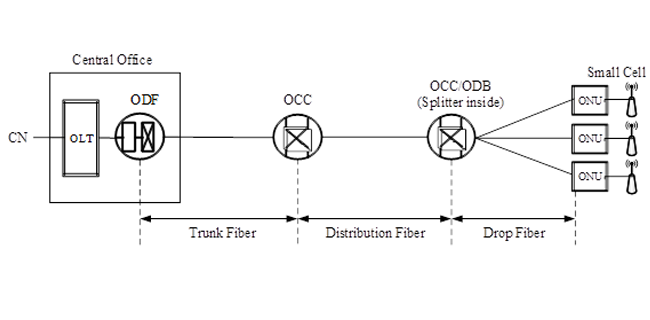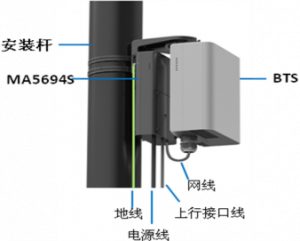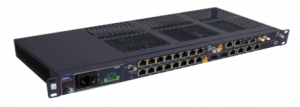The GSM Association (“Association”) makes no representation, warranty or undertaking (express or implied) with respect to and does not accept any responsibility for, and hereby disclaims liability for the accuracy or completeness or timeliness of the information contained in this document.
Executive Summary
As the number of small cells deployed increases, larger bandwidth and higher flexibility are required for the backhaul transportation, which consequentially leads to higher CapEX and OpEX. Therefore an economic and practical approach has to be put forwarded and verified
This case study focuses on the challenges of CapEX and OpEX of small cell backhaul. For coverage and/or capacity enhancement purpose, small cells will be deployed widely in the future. As networks evolve through 4.5G to 5G with more complexity, network densification and intelligence at the edge, the need will be even greater to optimise transport network architecture within mobile Radio Access Network (RAN) to resolve the challenges of backhaul/fronthaul demand and the corresponding increase in costs (CapEX and OpEX).
Small cell backhaul based on Passive Optical Network (PON) system, which can reduce at least 80% of the trunk fibre and 50% of associated fibre compared to legacy P2P fibre scenario. As a result making facility room and air-conditioning unnecessary. Therefore the CapEX and OpEx of small cell deployment could be reduced effectively and remarkably.
As networks evolve through 4.5G to 5G with more complexity, network densification and intelligence at the edge, the need will be even greater to optimise transport network architecture within mobile Radio Access Network (RAN) to resolve the challenges of backhaul/fronthaul demand and the corresponding increase in costs (CapEX and OpEX).
1 Introduction
China Telecommunications is one of the largest state-owned telecommunication companies in China. With the world’s largest broadband Internet network, Frequency Division Duplex – Long Term Evolution (FDD – LTE) mobile network, China Telecom is capable of providing cross-region, fully integrated information services to global customers through its sound customer service channel system. By the third quarter of 2018, the number of China Telecom’s broadband Internet subscribers exceeded 140 million and saw the number of mobile subscribers exceed 290 million.
2 Business Imperative
Small cells are primarily designed to enhance coverage and/or capacity. The site of small cells needs to be distributed discretely and randomly, which leads to higher demands towards both bandwidth and flexibility of its backhaul network.
2.1 Easy access
China Telecom has deployed a broadband access network based on PON throughout the entire country providing a Fibre to the Home (FTTH) service to 140 million residential customers (Q3 18). Based on positive laboratory and field testing results, China Telecom recommends small cell PON-based broadband access network as an optimal choice for small cell backhaul transportation. The benefits of this proposal include easy access, cost reduction and efficiency/flexibility. Optical Line Termination (OLT) or Optical Distribution Network (ODN) has been widely deployed by China Telecom, while topology P to MP is supported.
2.2 Cost reduction
The PON access network supporting the backhaul of the small base station can reuse the deployed OLT equipment, which can effectively reduce the equipment room occupancy and energy consumption requirements in the equipment room.
The terminal device can be miniaturised and inserted into a small base station in a Small Form-factor pluggable (SFP+) form. This can greatly reduce the space requirements and complexity of base station installation, base station air conditioning requirements, and power requirements such as power supply and heat dissipation
With the deployment of small cells, the coverage density is increasing and therefore is necessary to build a bearer network with low-cost deep coverage. The PON-based broadband access network has been deployed on a large scale with massive fibre extended to the user side enhancing the small cell coverage. Optical fibre infrastructure is one of the most important infrastructures for operators. It is expected to save valuable fibre resources by accessing small base stations through PON networks. Based on typical network model analysis (as shown in the below table), this approach can save at least 80% of the trunk fibre. The higher the density of the small base station, the greater the amount of trunk fibre saved. For distribution fibre, this can save approximately 50% of associated fibre resources.
| Example model: Ratio of Macro base station and small cell | 1:3 | 1:10 | |
| Small cell numbers covered per trunk fibre ring | 72 | 240 | |
| Small cell numbers covered per connection box | 12 | 40 | |
| PON access | Number of trunk fibre | 6 | 12 |
| Number of distribution fibre | 72 | 240 | |
| P2P | Number of trunk fibre | 144 | 480 |
| Number of distribution fibre | 144 | 480 | |
Table 1 Example cost comparison for PON access and P2P
2.3 Efficiency and flexibility
No extra fibre-optic cable deployment is required while terminal installation is supported.
 Figure 1 P to P structure of IPRAN/PTN
Figure 1 P to P structure of IPRAN/PTN
 Figure 2 P to MP structure of PON
Figure 2 P to MP structure of PON
3 FMC-based backhaul
3.1 Uplink Solution
Through Ethernet Passive Optical Network Optical Line Terminal (EPON OLT) equipment, small cells are linked to Router B of IP RAN network.
A traffic warning mechanism is enabled whenever uplink traffic is more than 50%. A warning is transferred whenever uplink traffic exceeds 70%, at this point network capacity expansion should be considered.

Figure 3 Uplink solution for backhaul based on PON
3.2 Downlink solution
Based on Ethernet electrical or fibre optical port, CBU equipment transports data to small cells.

Figure 4 Downlink solution for backhaul based on PON
3.3 Configuration
Specific IP and VLAN is configured to guarantee service isolation, priority-based scheduling is adopted and the bandwidth for each small cell is pre-reserved.
3.4 Laboratory and field experiment
In order to verify the functionality and performance of this solution, China Telecom collaborated closely with two companies; Huawei and ZTE, completing laboratory and field tests in Hubei and Shanghai.
We selected seven outdoor sites and one indoor site in Hubei, and eight outdoor sites in Shanghai. All the small cells were linked to EPON equipment, which had been updated (software and hardware) to support frequency and time synchronisation. Detailed information about CBUs and small cells in CT laboratory and field experiment are listed as follows.
| No. of sites | Type of HW BS | Type of ZTE BS | |
| HUBEI | 7 outdoor
1 indoor | BTS3203 | BS8912
BS8102 |
| SHANGHAI | 8 outdoor | BTS3202E | BS8912 |
Table 2 Small cells in CT Lab and Field experiment
| Manufacturer | Model No. | Type | |
| HUAWEI | CBU MA5694 | indoor |  |
| CBU MA5694S | outdoor |  | |
| ZTE | CBU F829 | Indoor outdoor |  |
Table 3 CBU in CT Lab and Field experiment
The test results proved the feasibility of this solution, the capability of relative equipment, and KPI performance. Therefore, making backhaul based PON a preferred choice for small cell backhaul transport.
3.4.1 KPI Performance
- Delay: The test results of transportation delay and handover delay are comparable to IPRAN system.
- Quality of Service (QoS): As mentioned above, service isolation is guaranteed between mobile and fixed services. Based on the trial operation of six months, QoS guarantee and qualified stability can be realised.
3.4.2 Equipment capability
- EPON/GPON/10G-EPON has the ability to transport small cell backhaul.
- Vendors could provide several types of equipment, including OLT, CBU and SFP, for different deployment scenarios.
4 Market Context
Based on the test results of above mentioned laboratory and field experiments suggestions on small cell backhaul based on PON can be divided into two main parts;
4.1 Deployment
- Connect a small cell to the nearest available ODN port
- For Uplink, small cells to be directly linked to IP RAN Router B or indirectly through switch.
- Specific OLT for small cells is not recommended in principle.
- CBU terminal with IEEE 1588 v2/SyncE is suggested if synchronisation is required; SFU or MDU are suggested if synchronisation is not required.
4.2 Configuration
- Specific VLAN for small cell backhaul is recommended in order to be isolated logically from other services.
- QoS functionality is required while a high priority level for small cell backhaul has to be set in OLT and ONU equipment.
- For uplink, the guaranteed bandwidth in ONU is 50Mbps, the maximum bandwidth is 100Mbps.
5 Conclusion / Summary
China Telecom has a nation-wide broadband access network based on PON, we propose small cell deployment based on PON, as it leads to higher efficiency, flexibility and cost reduction. Based on theoretical and statistical analysis, at least 80% of the trunk fibre, and 50% of associated fibre can potentially be saved.
China Telecom has conducted laboratory and field test in Hubei and Shanghai cities, with Huawei and ZTE. The test results proved the feasibility of this solution, while the capability of relative equipment and KPI performance are also satisfied. Therefore, we believe that backhaul based PON could be a preferred choice for small cell backhaul transport.
Following inputs and indicative cost reduction assumptions from a case study involving 5G-PON, the GSMA Network Economics model estimated potential savings in OpEX and CapEX for typical operators across four different segments1.
